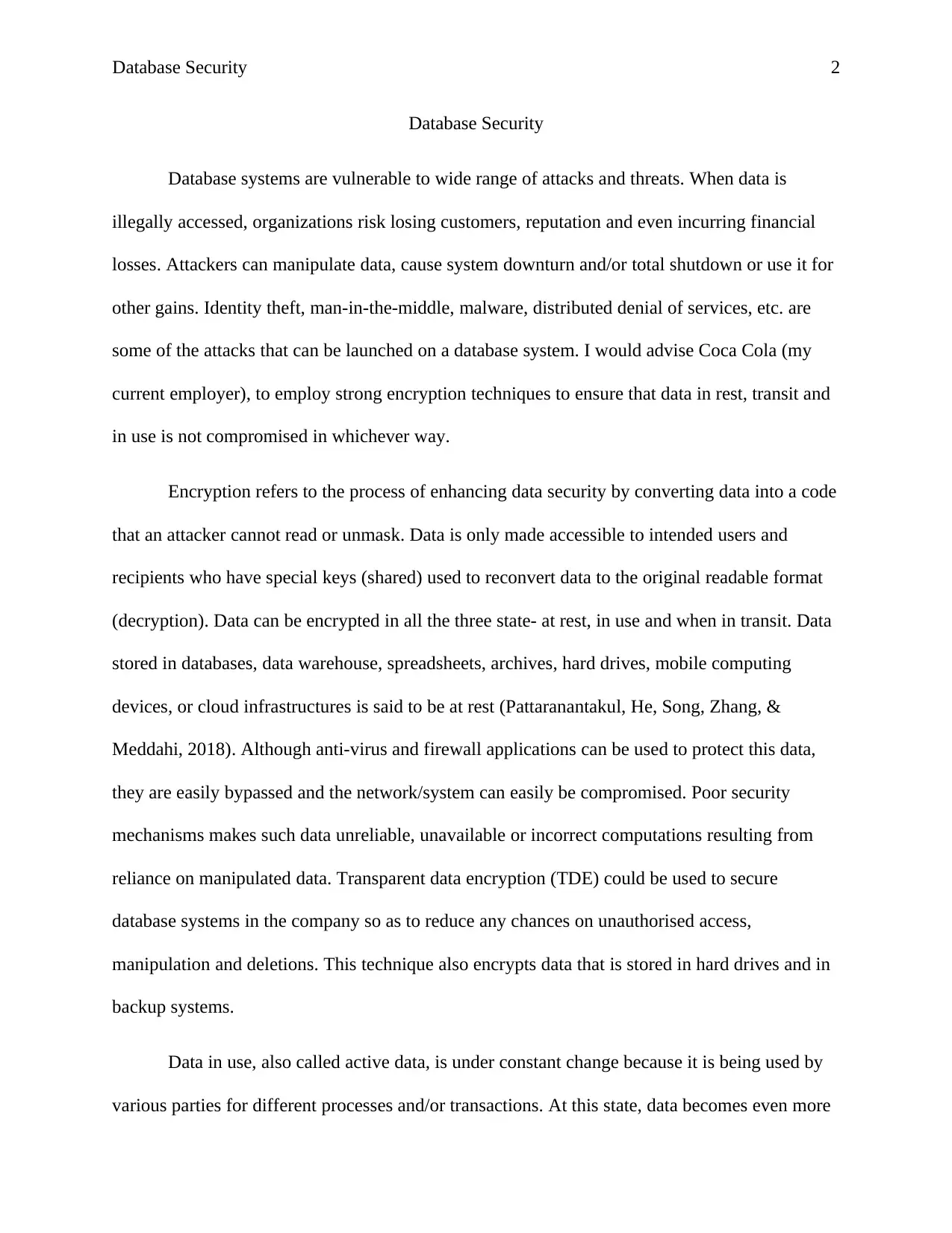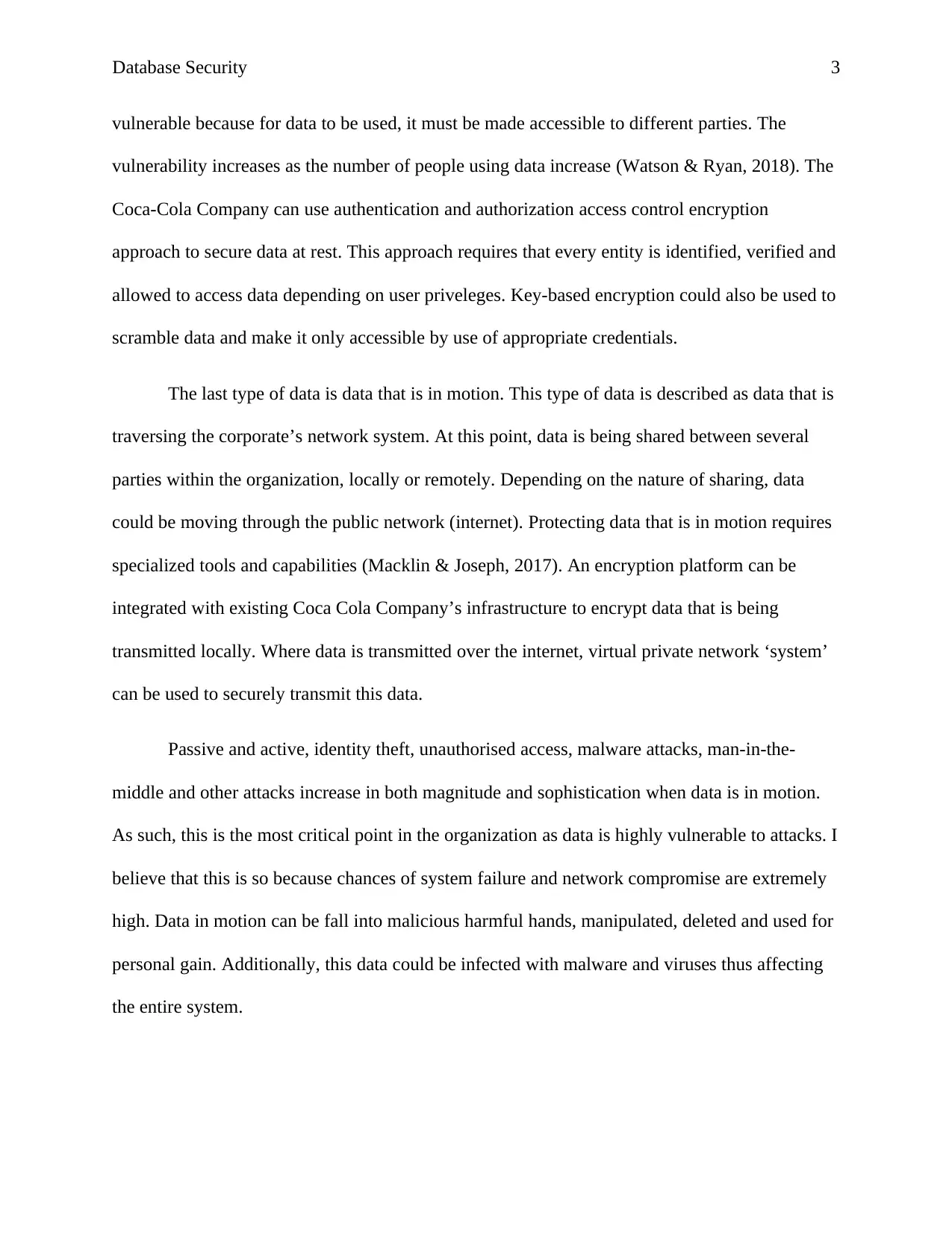Database Security Report: Threats, Solutions, and Coca-Cola's Strategy
VerifiedAdded on 2022/12/20
|4
|824
|76
Report
AI Summary
This report addresses database security concerns, emphasizing the vulnerability of database systems to various attacks, including identity theft, malware, and denial-of-service attacks. The author, an employee of Coca-Cola, recommends strong encryption techniques as a primary defense, covering data at rest, in transit, and in use. The report details different encryption approaches, such as Transparent Data Encryption (TDE) for data at rest, authentication and authorization for data in use, and virtual private networks (VPNs) for data in motion. The importance of securing data in motion is highlighted due to its high vulnerability. References from academic sources support the recommendations.

Running head: Database Security 1
Database Security
Name of the Student
Name of the Institution
Database Security
Name of the Student
Name of the Institution
Paraphrase This Document
Need a fresh take? Get an instant paraphrase of this document with our AI Paraphraser

Database Security 2
Database Security
Database systems are vulnerable to wide range of attacks and threats. When data is
illegally accessed, organizations risk losing customers, reputation and even incurring financial
losses. Attackers can manipulate data, cause system downturn and/or total shutdown or use it for
other gains. Identity theft, man-in-the-middle, malware, distributed denial of services, etc. are
some of the attacks that can be launched on a database system. I would advise Coca Cola (my
current employer), to employ strong encryption techniques to ensure that data in rest, transit and
in use is not compromised in whichever way.
Encryption refers to the process of enhancing data security by converting data into a code
that an attacker cannot read or unmask. Data is only made accessible to intended users and
recipients who have special keys (shared) used to reconvert data to the original readable format
(decryption). Data can be encrypted in all the three state- at rest, in use and when in transit. Data
stored in databases, data warehouse, spreadsheets, archives, hard drives, mobile computing
devices, or cloud infrastructures is said to be at rest (Pattaranantakul, He, Song, Zhang, &
Meddahi, 2018). Although anti-virus and firewall applications can be used to protect this data,
they are easily bypassed and the network/system can easily be compromised. Poor security
mechanisms makes such data unreliable, unavailable or incorrect computations resulting from
reliance on manipulated data. Transparent data encryption (TDE) could be used to secure
database systems in the company so as to reduce any chances on unauthorised access,
manipulation and deletions. This technique also encrypts data that is stored in hard drives and in
backup systems.
Data in use, also called active data, is under constant change because it is being used by
various parties for different processes and/or transactions. At this state, data becomes even more
Database Security
Database systems are vulnerable to wide range of attacks and threats. When data is
illegally accessed, organizations risk losing customers, reputation and even incurring financial
losses. Attackers can manipulate data, cause system downturn and/or total shutdown or use it for
other gains. Identity theft, man-in-the-middle, malware, distributed denial of services, etc. are
some of the attacks that can be launched on a database system. I would advise Coca Cola (my
current employer), to employ strong encryption techniques to ensure that data in rest, transit and
in use is not compromised in whichever way.
Encryption refers to the process of enhancing data security by converting data into a code
that an attacker cannot read or unmask. Data is only made accessible to intended users and
recipients who have special keys (shared) used to reconvert data to the original readable format
(decryption). Data can be encrypted in all the three state- at rest, in use and when in transit. Data
stored in databases, data warehouse, spreadsheets, archives, hard drives, mobile computing
devices, or cloud infrastructures is said to be at rest (Pattaranantakul, He, Song, Zhang, &
Meddahi, 2018). Although anti-virus and firewall applications can be used to protect this data,
they are easily bypassed and the network/system can easily be compromised. Poor security
mechanisms makes such data unreliable, unavailable or incorrect computations resulting from
reliance on manipulated data. Transparent data encryption (TDE) could be used to secure
database systems in the company so as to reduce any chances on unauthorised access,
manipulation and deletions. This technique also encrypts data that is stored in hard drives and in
backup systems.
Data in use, also called active data, is under constant change because it is being used by
various parties for different processes and/or transactions. At this state, data becomes even more

Database Security 3
vulnerable because for data to be used, it must be made accessible to different parties. The
vulnerability increases as the number of people using data increase (Watson & Ryan, 2018). The
Coca-Cola Company can use authentication and authorization access control encryption
approach to secure data at rest. This approach requires that every entity is identified, verified and
allowed to access data depending on user priveleges. Key-based encryption could also be used to
scramble data and make it only accessible by use of appropriate credentials.
The last type of data is data that is in motion. This type of data is described as data that is
traversing the corporate’s network system. At this point, data is being shared between several
parties within the organization, locally or remotely. Depending on the nature of sharing, data
could be moving through the public network (internet). Protecting data that is in motion requires
specialized tools and capabilities (Macklin & Joseph, 2017). An encryption platform can be
integrated with existing Coca Cola Company’s infrastructure to encrypt data that is being
transmitted locally. Where data is transmitted over the internet, virtual private network ‘system’
can be used to securely transmit this data.
Passive and active, identity theft, unauthorised access, malware attacks, man-in-the-
middle and other attacks increase in both magnitude and sophistication when data is in motion.
As such, this is the most critical point in the organization as data is highly vulnerable to attacks. I
believe that this is so because chances of system failure and network compromise are extremely
high. Data in motion can be fall into malicious harmful hands, manipulated, deleted and used for
personal gain. Additionally, this data could be infected with malware and viruses thus affecting
the entire system.
vulnerable because for data to be used, it must be made accessible to different parties. The
vulnerability increases as the number of people using data increase (Watson & Ryan, 2018). The
Coca-Cola Company can use authentication and authorization access control encryption
approach to secure data at rest. This approach requires that every entity is identified, verified and
allowed to access data depending on user priveleges. Key-based encryption could also be used to
scramble data and make it only accessible by use of appropriate credentials.
The last type of data is data that is in motion. This type of data is described as data that is
traversing the corporate’s network system. At this point, data is being shared between several
parties within the organization, locally or remotely. Depending on the nature of sharing, data
could be moving through the public network (internet). Protecting data that is in motion requires
specialized tools and capabilities (Macklin & Joseph, 2017). An encryption platform can be
integrated with existing Coca Cola Company’s infrastructure to encrypt data that is being
transmitted locally. Where data is transmitted over the internet, virtual private network ‘system’
can be used to securely transmit this data.
Passive and active, identity theft, unauthorised access, malware attacks, man-in-the-
middle and other attacks increase in both magnitude and sophistication when data is in motion.
As such, this is the most critical point in the organization as data is highly vulnerable to attacks. I
believe that this is so because chances of system failure and network compromise are extremely
high. Data in motion can be fall into malicious harmful hands, manipulated, deleted and used for
personal gain. Additionally, this data could be infected with malware and viruses thus affecting
the entire system.
⊘ This is a preview!⊘
Do you want full access?
Subscribe today to unlock all pages.

Trusted by 1+ million students worldwide

Database Security 4
References
Macklin, T., & Joseph, M. (2017). Big data, little security: Addressing security issues in your
platform. Next-Generation Analyst V, 10207.
Pattaranantakul, M., He, R., Song, Q., Zhang, Z., & Meddahi, A. (2018). NFV Security Survey:
From Use Case Driven Threat Analysis to State-of-the-Art Countermeasures. EEE
Communications Surveys & Tutorials, 20(4), 3330-3368.
Watson, D., & Ryan, M. (2018). GDPR and employee data protection: Cyber security data
example. Cyber Security: A Peer-Reviewed Journal, 2(1), 23-30.
References
Macklin, T., & Joseph, M. (2017). Big data, little security: Addressing security issues in your
platform. Next-Generation Analyst V, 10207.
Pattaranantakul, M., He, R., Song, Q., Zhang, Z., & Meddahi, A. (2018). NFV Security Survey:
From Use Case Driven Threat Analysis to State-of-the-Art Countermeasures. EEE
Communications Surveys & Tutorials, 20(4), 3330-3368.
Watson, D., & Ryan, M. (2018). GDPR and employee data protection: Cyber security data
example. Cyber Security: A Peer-Reviewed Journal, 2(1), 23-30.
1 out of 4
Related Documents
Your All-in-One AI-Powered Toolkit for Academic Success.
+13062052269
info@desklib.com
Available 24*7 on WhatsApp / Email
![[object Object]](/_next/static/media/star-bottom.7253800d.svg)
Unlock your academic potential
Copyright © 2020–2025 A2Z Services. All Rights Reserved. Developed and managed by ZUCOL.




